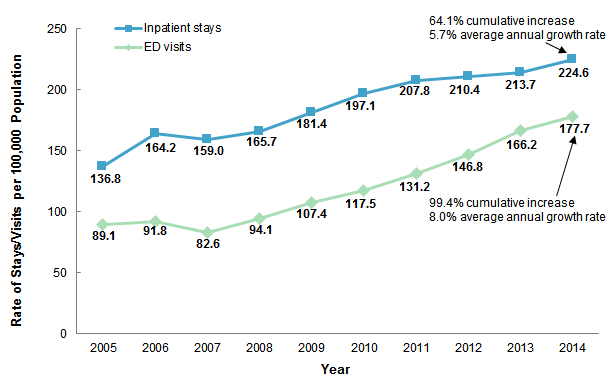
Opioid-Related Emergency Department Care
Massachusetts, Rhode Island, Maryland, Ohio and Connecticut were the states with the highest rates of opioid-related emergency department visits in 2014. (Source: Agency for Healthcare Research and Quality, Healthcare Cost and Utilization Project Statistical Brief #219: Opioid-Related Impatient Stays and Emergency Department Visits by State, 2009-2014.)

Audrey J. Weiss, Ph.D., Anne Elixhauser, Ph.D., Marguerite L. Barrett, M.S., Claudia A. Steiner, M.D., M.P.H., Molly K. Bailey, and Lauren O'Malley Introduction The opioid epidemic has reached alarming levels in many parts of the United States, affecting the lives of thousands of individuals and families. Between 2000 and 2014, the rate of overdose deaths involving opioids in the United States increased 200 percent.1 Between 2013 and 2014 alone, the rate of opioid overdose deaths increased 14 percent, from 7.9 to 9.0 per 100,000 population.2 Hospitalizations related to opioid misuse and dependence also have increased dramatically, with the rate of adult hospital inpatient stays per 100,000 population nearly doubling between 2000 and 2012.3 The substantial increase over the past decade in the misuse of opioids, which include prescription opioids and illicit opioids such as heroin, has been declared an "opioid epidemic" by the U.S. Department of Health and Human Services (HHS).4 In March 2015, HHS launched its Opioid Initiative to help reverse the increasing trend in opioid misuse, use disorder, and overdoses, and to support State efforts to address the opioid crisis.5 In response to HHS initiatives, in December 2016 the Agency for Healthcare Research and Quality released statistics on opioid-related hospital use by State in the interactive, online tool for the Healthcare Cost and Utilization Project (HCUP), HCUP Fast Stats.6 This HCUP Statistical Brief presents data from HCUP Fast Stats on the national rate of opioid-related hospital inpatient stays and emergency department (ED) visits from 2005 to 2014. Rates for more than 40 individual States and the District of Columbia are provided for 2014 along with changes in rates for the 6-year period from 2009 to 2014. Identification of opioid-related stays and visits is based on all-listed diagnoses and includes events associated with prescription opioids or illicit opioids such as heroin. Differences greater than 10 percent between estimates are noted in the text. Findings National rate of opioid-related inpatient stays and ED visits, 2005-2014 Figure 1 presents the national rate per 100,000 population of opioid-related inpatient stays and ED visits from 2005 through 2014. |
|
Figure 1. National rate of opioid-related inpatient stays and emergency department visits, 2005-2014  Abbreviation: ED, emergency department Source: Agency for Healthcare Research and Quality (AHRQ), Center for Delivery, Organization, and Markets, Healthcare Cost and Utilization Project (HCUP), HCUP Fast Stats, Opioid-Related Hospital Use (http://www.hcup-us.ahrq.gov/faststats/landing.jsp) based on the HCUP National (Nationwide) Inpatient Sample (NIS) and the HCUP Nationwide Emergency Department Sample (NEDS) |
































No hay comentarios:
Publicar un comentario